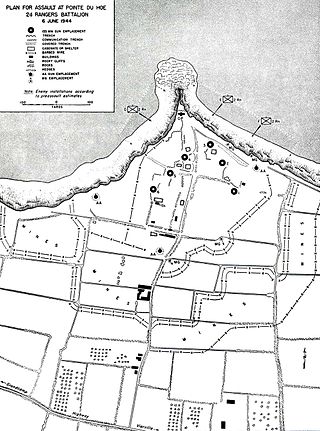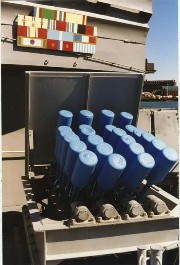A transatlantic telecommunications cable is a submarine communications cable connecting one side of the Atlantic Ocean to the other. In the 19th and early 20th centuries, each cable was a single wire. After mid-century, coaxial cable came into use, with amplifiers. Late in the 20th century, all cables installed used optical fiber as well as optical amplifiers, because distances range thousands of kilometers.

A projectile is an object that is propelled by the application of an external force and then moves freely under the influence of gravity and air resistance. Although any objects in motion through space are projectiles, they are commonly found in warfare and sports.

Transatlantic telegraph cables were undersea cables running under the Atlantic Ocean for telegraph communications. Telegraphy is now an obsolete form of communication, and the cables have long since been decommissioned, but telephone and data are still carried on other transatlantic telecommunications cables. The first cable was laid in the 1850s from Valentia Island off the west coast of Ireland to Bay of Bulls, Trinity Bay, Newfoundland. The first communications occurred on August 16th 1858, but the line speed was poor, and efforts to improve it caused the cable to fail after three weeks.

A winch is a mechanical device that is used to pull in or let out or otherwise adjust the tension of a rope or wire rope.

The Hedgehog was a forward-throwing anti-submarine weapon that was used primarily during the Second World War. The device, which was developed by the Royal Navy, fired up to 24 spigot mortars ahead of a ship when attacking a U-boat. It was deployed on convoy escort warships such as destroyers and corvettes to supplement the depth charges.

La Pointe du Hoc is a promontory with a 35-metre (110 ft) cliff overlooking the English Channel on the northwestern coast of Normandy in the Calvados department, France.

An anti-submarine weapon (ASW) is any one of a number of devices that are intended to act against a submarine and its crew, to destroy (sink) the vessel or reduce its capability as a weapon of war. In its simplest sense, an anti-submarine weapon is usually a projectile, missile or bomb that is optimized to destroy submarines.

A ranged weapon is any weapon that can engage targets beyond hand-to-hand distance, i.e. at distances greater than the physical reach of the user holding the weapon itself. The act of using such a weapon is also known as shooting. It is sometimes also called projectile weapon or missile weapon because it typically works by launching solid projectiles ("missiles"), though technically a fluid-projector and a directed-energy weapon are also ranged weapons. In contrast, a weapon intended to be used in hand-to-hand combat is called a melee weapon.

A grapple is a hook or claw used to catch or hold something. A ship's anchor is a type of grapple, especially the "grapnel" anchor.

USS Satterlee (DD-626) was a Gleaves-class destroyer in the United States Navy during World War II. She is the second Navy ship named for United States Coast Guard Captain Charles Satterlee.
Anti-submarine mortars are artillery pieces deployed on ships for the purpose of sinking submarines by a direct hit with a small explosive charge. They are often larger versions of the mortar used by infantry and fire a projectile in relatively the same manner. They were created during World War II as a development of the depth charge and work on the same principle.

An umbilical cable or umbilical is a cable and/or hose that supplies required consumables to an apparatus, like a rocket, or to a person, such as a diver or astronaut. It is named by analogy with an umbilical cord. An umbilical can, for example, supply air and power to a pressure suit or hydraulic power, electrical power and fiber optics to subsea equipment and divers.
The Mountain Leader Training Cadre is a training element of the United Kingdom's Royal Marines which provides instruction in mountain warfare, arctic warfare, cold weather survival and operations, and cliff assault. The cadre has a permanent staff of mountain and arctic warfare instructors and trains mountain leaders for employment in the formations of the corps. The cadre is part of the Mountain Leader and ISTAR Company within Specialist Wing of the Commando Training Centre Royal Marines and is based in Lympstone.

A toggle rope was part of the standard equipment of British commandos and the Parachute Regiment during World War II. It was 6 feet (1.8 m) long, and had a toggle at one end in a tightly fitting eye splice, with a larger eye at the other end. This enabled them to be fastened together to create an ersatz rope ladder, or to secure around a bundle for hauling, among other uses as well as an ad-hoc truncheon. The ropes were carried around the commandos and paratroopers waists while not in use. The toggle rope was also used by US Army Rangers and Australia in the Vietnam War as the fibre rope assembly, single leg, polyester fibre, 1in circ. 9ft long Later variants of the nylon rope lacked the toggle and was 10mm x 4m long and was stored in a 1 ft long coil when stashed away. Modern day issued variants are the Platatac toggle rope.

Leonard G. "Bud" Lomell was a highly decorated former United States Army Ranger who served in World War II. He is best known for his actions in the first hours of D-Day at Pointe du Hoc on the coast of Normandy, France.
The Provisional Ranger Group was a provisional regiment of U.S. Army Rangers that was formed for the D-Day landings in Normandy, France, in World War II.
Pneumatic line throwers can be used for a variety of applications including underway replenishment (UNREPS), replenishment at sea (RASing), ship to ship line deployment, ship to shore line deployment, water rescue, high angle rescue, cable running in industrial applications, and tactical line deployment. Line throwers come in two categories: pyrotechnic and pneumatic.
A line thrower is a device that casts a line to a remote position. It is used in rescues as well as marine operations. A line thrower may employ a variety of launching methods including guns, rockets, and pneumatics.

A hook is a tool consisting of a length of material, typically metal, that contains a portion that is curved/bent back or has a deeply grooved indentation, which serves to grab, latch or in any way attach itself onto another object. The hook's design allows traction forces to be relayed through the curved/indented portion to and from the proximal end of the hook, which is either a straight shaft or a ring for attachment to a thread, rope or chain, providing a reversible attachment between two objects.

Martha's Vineyard was founded in 1602 and became a popular summertime location. Year round it is home to a population of around 10,000 people and in the summertime it spikes to over 100,000 people. In World War II the people that flocked to Martha's Vineyard were soldiers. With Camp Edwards being on Cape Cod, Martha's Vineyard became used as a training ground for the soldiers. Martha's Vineyard was used by the Army, Navy and Air Force from 1941 through 1945 with training missions that ranged from landings on beaches, climbing cliffs and bombing practice.

















